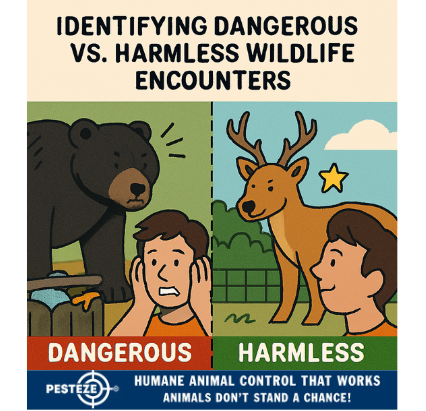IDENTIFYING DANGEROUS VS. HARMLESS WILDLIFE ENCOUNTERS

IDENTIFYING DANGEROUS VS. HARMLESS WILDLIFE ENCOUNTERS
SUMMARY
Not all wildlife encounters are cause for alarm, but knowing how to distinguish between harmless and potentially dangerous situations is essential for safety. Whether you're hiking, gardening, or simply enjoying nature, understanding animal behavior and risk factors can help you respond appropriately. This guide breaks down key signs, species traits, and response strategies to help you stay safe while respecting wildlife boundaries.
FEATURES
-
Recognizing Threatening Behavior: Learn how posture, vocalizations, and movement signal danger.
-
Common Harmless Encounters: Identify species that pose little to no threat when left undisturbed.
-
Time and Location Awareness: Understand when and where wildlife is most likely to be active.
-
Protecting Pets and Children: Know how to safeguard vulnerable family members during encounters.
-
Avoiding Provocation: Discover how to prevent escalation through calm, non-invasive actions.
-
Reporting and Documentation: Learn when to notify authorities and how to record sightings responsibly.
GUIDE DESCRIPTION
Wildlife encounters are a natural part of outdoor life, but not all animals pose the same level of risk. This guide helps you distinguish between dangerous and harmless wildlife interactions, empowering you to make informed decisions in the moment.
Start by observing behavior. Animals that appear agitated—growling, hissing, charging, or showing teeth—may be defending territory, offspring, or feel threatened. These are signs to back away slowly and avoid eye contact. In contrast, animals that remain calm, forage, or pass by without engaging are typically harmless if left alone.
Species identification is key. Venomous snakes, large predators like bears or mountain lions, and aggressive birds during nesting season require caution. Meanwhile, squirrels, rabbits, and most songbirds are non-threatening unless cornered or sick.
Time and location matter. Dawn and dusk are peak activity times for many animals, especially predators. Be extra alert in wooded areas, near water sources, or during mating seasons when animals may be more territorial.
Protect pets and children by keeping them close and quiet. Small pets should be leashed or kept indoors during high-risk hours. Teach children to observe wildlife from a distance and never attempt to touch or feed animals.
Avoid provoking wildlife. Loud noises, sudden movements, or approaching too closely can escalate a harmless encounter into a dangerous one. Stay calm, speak softly, and retreat slowly if needed.
If you witness unusual or aggressive behavior, report it to local wildlife authorities. Documenting the encounter with photos or notes can help officials monitor animal activity and ensure public safety.
By learning to read wildlife cues and respond appropriately, you’ll enjoy nature more confidently and contribute to peaceful human-animal coexistence.
- Amy Chang


Comments 0